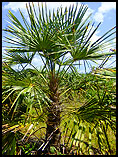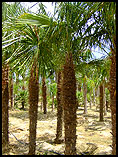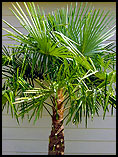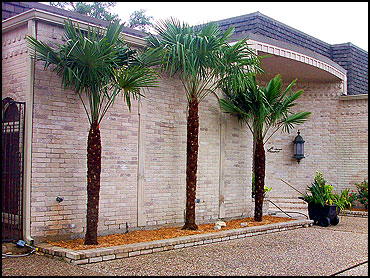
| << back to palms list Windmill Palm (Trachycarpus fortunei) |
   Click to Enlarge Photos   From 6-12' Clear Trunk  |
Description Windmill palm is one of the most cold hardy palms available. It is beautifully compact and grows to heights of 20-40 ft (6.1-12.2 m). Windmill palm has a rather slender single stem that is 8-10 in (20-25 cm) in diameter and is typically a bit narrower at the base than at the top. Trunks are usually covered with a loose mat of coarse gray or brown fiber. In older individuals the fiber sloughs away to reveal a smooth ringed surface. Chusan palm, as it is also commonly called, has light to dark green palmate leaves that are lighter, almost silvery (glaucous), on the underside. They are held on thin 3 ft (0.9 m) flattened stems that are finely toothed along both edges. Leaves are circular, about 3 ft (0.9 m) in diameter and segmented about halfway. They are flat with leaf segment tips held stiffly, but occasionally you will see individuals with droopy tips. Leaves are arranged into a symmetrical crown that is about 8-10 ft (2.5-3 m) wide. Specimens grown in full sun and/or under poor conditions may have much smaller, more compact crowns. Male and female flowers are borne on separate plants (so this palm is said to be dioecious). They are densely arranged on 2-3 ft (0.6-0.9 m) long branched stalks called an inflorescence. The windmill palm's bright yellow inflorescence erupts from a packetlike bud in late winter and early spring and is held within the crown. On female plants the flowers are followed in late summer by round or oblong blue fruits that are about 1/2 in (1.3 cm) in diameter. Location Chinese fan palm is native to temperate and subtropical mountainous areas of Asia including southeastern China, Taiwan and the Chusan Islands. It is commonly grown as a landscape specimen in central and northern Florida, the southeastern U.S. Atlantic and Gulf Coasts, and in mild areas along the west coast. It has been sighted in northerly latitudes from Charlotte, North Carolina to Atlanta, Georgia to Vancouver, British Columbia. This picture perfect hardy palm is an internationalist who decorates postcards from Lake Como in Italy, the southern coasts of the British Isles and the Crimean Peninsula. Culture Windmill palm does best in well drained soils with above average fertility but it will survive in almost anything except perpetually soggy conditions. It is moderately salt tolerant and can be planted behind the first line dunes or against a structure that will shield it from direct exposure to sea breezes. Light: Partial shade is best. Moisture: Adequate moisture makes for rapid growth and best appearance but it is amazingly drought tolerant as well (although plants will appear stunted and growth rate dramatically slowed if regular watering is withheld). Hardiness: USDA Zones 7B-10. This is a hardy palm and can withstand subfreezing temperatures. In its native habitat, this tough palm is sometimes subjected to a cover of snow and ice. Note that this plant should be planted in sheltered sites when grown in Zone 7. Propagation: Windmill palm seeds will germinate in 8 to 12 weeks without a lot of fuss. Usage This palm makes a great accent which fits well into small areas like courtyards and entries. It is a tough plant and survives in hot urban landscapes and even thrives there if watered and fed. Chusan palm is perfect for containers if care is taken that they are well drained. It is very attractive planted in groves and groupings especially when plants of different heights are staggered in irregular patterns (plant the tallest palms in center of the groups and shorter ones at the edges). Features Chinese windmill palm is fast growing (if cared for), inexpensive and readily available. There are about six species in the genus Trachycarpus of which T. fortunei is the most familiar and most often seen. However it appears that the windmill palms offered by retail garden stores probably represent several different species and hybrids among these species. I grow about two dozen of these that I've purchased from various outlets. They show marked variability in form, hardiness, and growth rate. T. martianus has a more slender trunk than windmill palm (T. fortunei) and grows slightly taller. Leaves are held more erect and the crown is looser and more open. It is also seems to be less hardy (I lost two of these to freezes in the past couple of years while my other Trachycarpus species were unaffected). T. wagneranus has slightly smaller leaves that are held in a more compact crown. T. nanus is a dwarf whose stem forms underground. It is a very slow grower. There are a couple other species but confusion exists over whether these are distinct species or subspecies of T. fortunei. |
Copyright © 2008-2018 Groundworks, All Rights Reserved.
The Professionals Choice for Specimen Palms Since 1986
800-753-5127